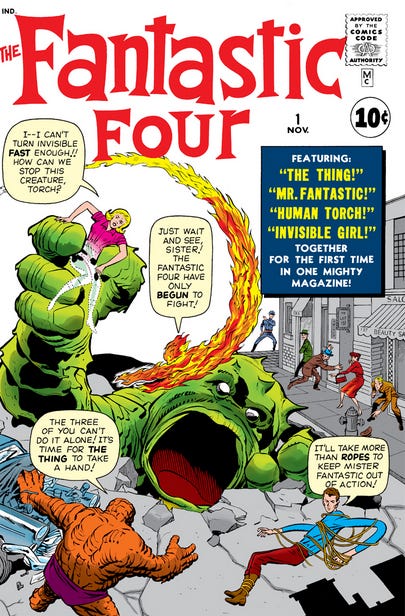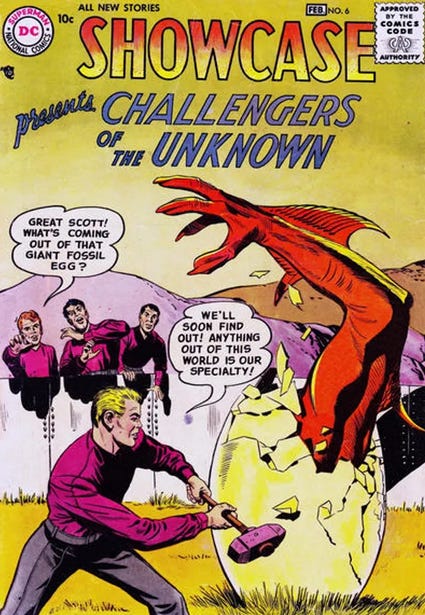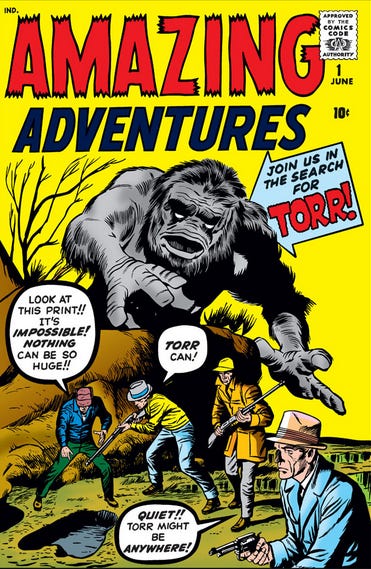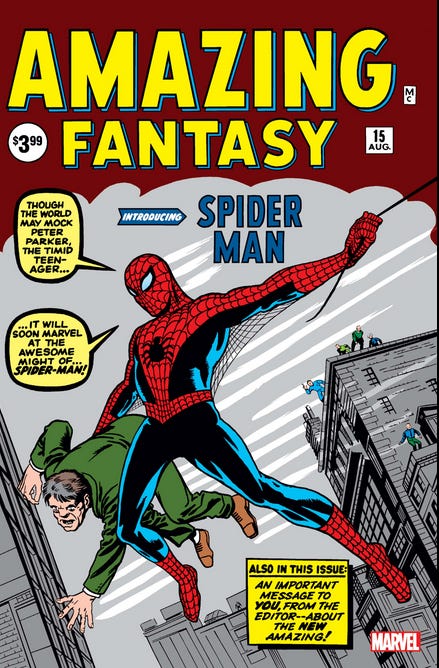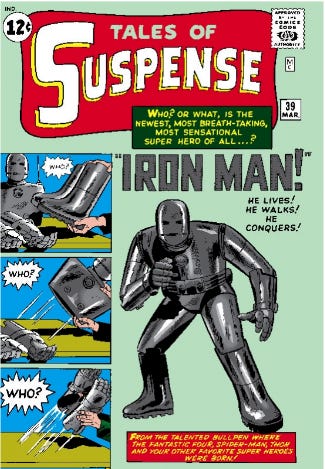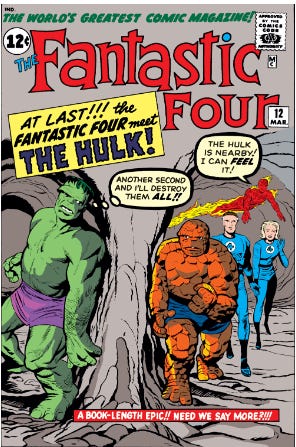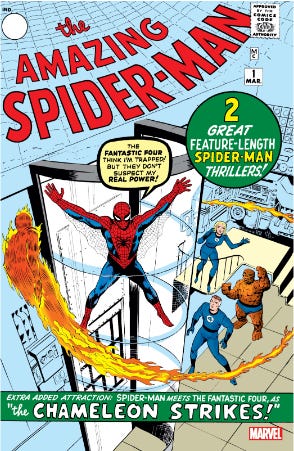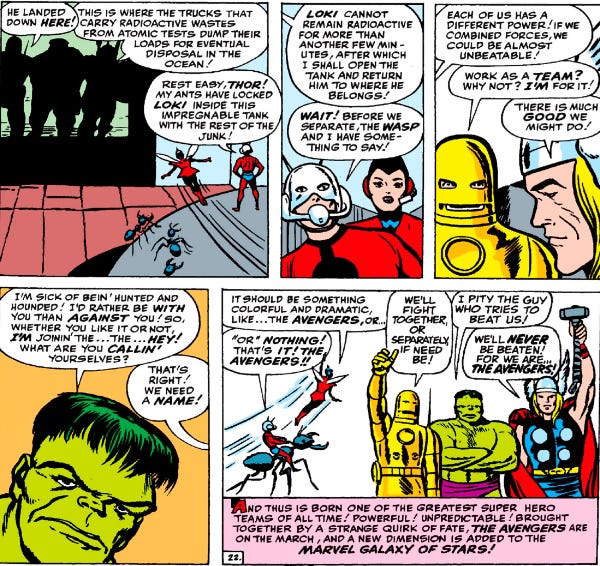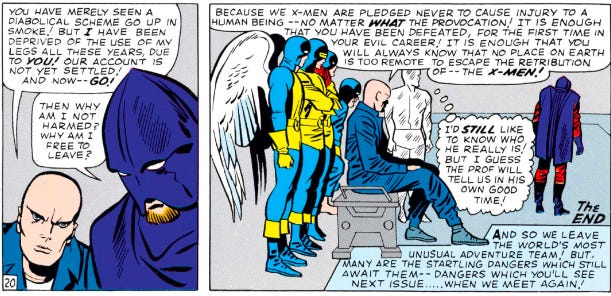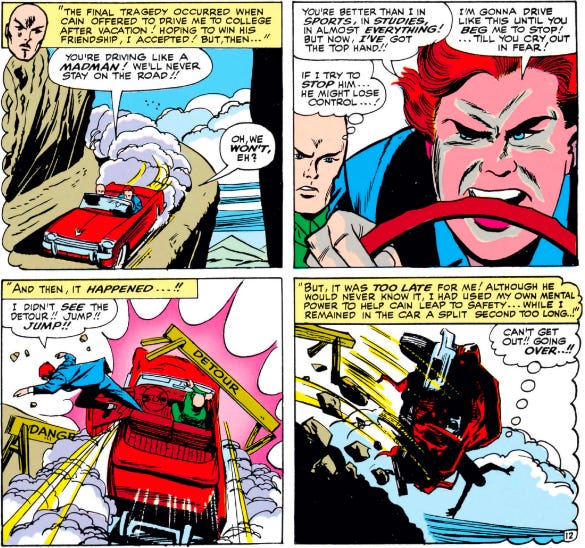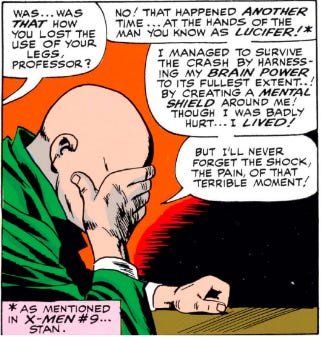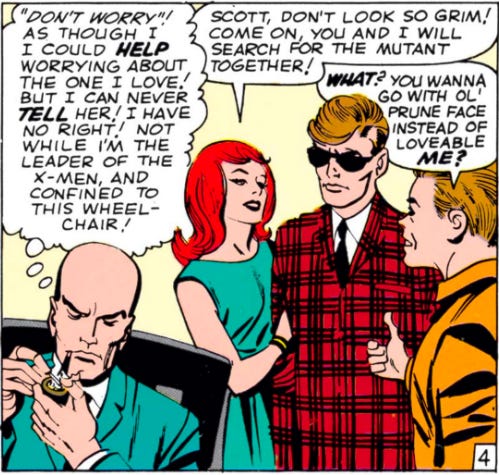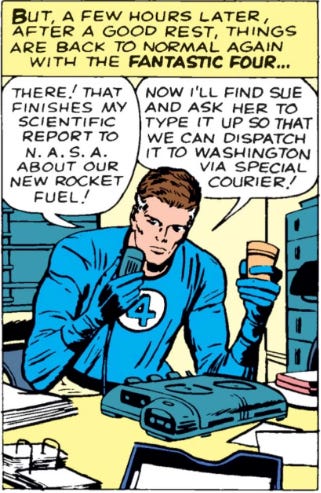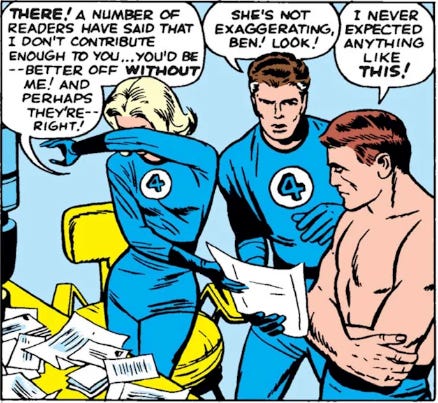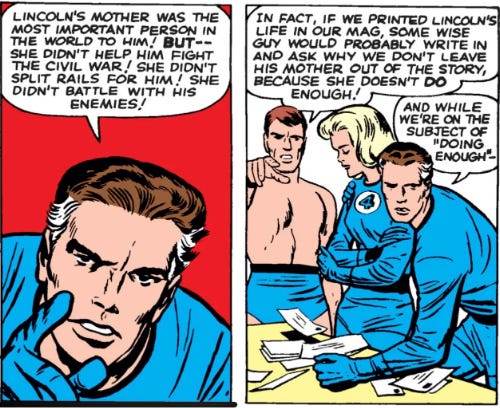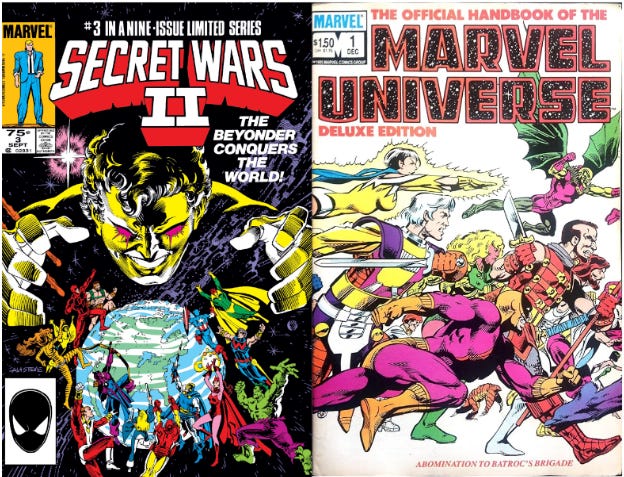Your Book Review: Silver Age Marvel Comics
[This is one of the finalists in the 2024 book review contest, written by an ACX reader who will remain anonymous until after voting is done. I’ll be posting about one of these a week for several months. When you’ve read them all, I’ll ask you to vote for a favorite, so remember which ones you liked] You are a serious person with serious interests. The last comic book you read was more likely by Bryan Caplan than Jonathan Hickman. You would prefer to be reading high quality book reviews on AstralCodexTen. You believe ACX book reviews are usually more insightful than the books themselves, and a far more efficient use of your time. But even book reviews take time to process, and there are a lot of book reviews to read. Why spend your valuable time reading an 11,000 word review of superhero comic books? That is the first question I aim to answer in this review. If I am successful, maybe you will invest a little more time to discover the answer to the next four questions. The questions:
I. Why Review Silver Age Marvel Comics?
I.a. Why Superhero Comic Books?The winner of last year’s Astral Codex Ten book review contest was Brandon Hendrickson. Brandon wrote about Kieran Egan’s The Educated Mind. One of the foundations of Egan’s educational philosophy is that people learn through stories. He believes early education should focus on teaching lessons through myths and legends. This matches my experience. My kids’ favorite podcast is Greeking Out – a very well produced, very entertaining, National Geographic podcast about Greek Legends.
Every culture has foundational myths. These stories are entertaining and engaging, but they also teach valuable lessons about both what is important in that culture, and how people in that culture are expected to behave (or at least the Platonic Ideal of how they should behave). In the modern, Western world, we have assimilated many of these foundational stories, particularly the Greek myths. My kids definitely know the Greek myths, but they also know elements of Norse mythology, Egyptian myths, stories about Anasi from West Africa and more. More fundamentally my wife and I, while not religious ourselves, have made a point of exposing the kids to the stories from the Bible. It is not politically correct to call Biblical stories “myths”, but they serve the same purpose – shared cultural understanding of the way the world works. My wife grew up without any religion, and when she was in high school, she struggled with the metaphors and religious allegories that were omnipresent in most of the Western canon. In our culture, familiarity with the Bible is important for an educated person – whether they are religious or not – because it is the foundation of so much of the rest of our culture. I believe the other set of mythological stories that are foundational to our culture are – and by this point I am sure you see where I am going here – comic book superheroes. If true, then having more than a surface-level understanding of the most important superhero stories is important in a similar way to that knowing the Bible stories is important. “Do unto others as you would have them do unto you” is an important idea to understand. So is, “With great power comes great responsibility”. I.b. Why Marvel?While there are many independent superheroes that are not owned by major conglomerates, the superheroes who have built our modern foundational myths are currently owned by two corporations. Warner Bros. Discover owns the DC library of superheroes including Superman, Batman and Wonder Woman. In 2009 Disney purchased Marvel Comics and took ownership of their characters, including Spiderman, X-men and the Avengers.
In the early aughts Marvel wanted to build their own film franchise, but were limited to only using their remaining “B-list” characters – Spider-man, X-men, and the Fantastic Four were all off limits. Fortunately, Kevin Feige, president of production for Marvel at the time, saw a way forward. He convinced Ike Perlmutter, Marvel CEO, to allow for the production of a series of films with the remaining characters begining with Iron Man (2008). Jon Favreau directed and cast Robert Downey Jr as Tony Stark. The film blew away expectations. Kevin’s plan of a series of movies where the characters would interconnect was suddenly feasible. Iron Man was followed by The Incredible Hulk, Thor, and Captain America: The First Avenger. None managed the box office magic of Iron Man, but all were successful enough that the plan stayed on track. In 2012 the characters were all brought together in the first Avengers film, which opened to over $200MM domestically and went on to gross more than $1.5B (which made it the 3rd highest grossing film of all time). Marvel became the first studio to take the interconnected world of their comic books and make the model work on the big screen (for a much larger audience). Once the model was proven to work, other studios tried to duplicate it.
At least so far, no studio has successfully created anything with close to the traction obtained by the Marvel Cinematic Universe (MCU). Warner’s DC Extended universe (DCEU) had trifling success, but is being shelved and rebooted for a fresh attempt next year. Universal’s attempt at a “Dark Universe” kicked off with Tom Cruise in The Mummy (2017), but was dead on arrival. Paramount’s attempt to link the Transformers Universe to GI Joe at the end of Transformers: Rise of the Beasts has been appropriately mocked. Sony’s Spider-man films linked to the MCU have been very successful, but their attempt at a stand-alone non-MCU Spider-man universe using Spider-man’s villains as anti-heroes has floundered (mostly succeeding only as a source of memes). Next Mattel will be attempting to build a universe off the success of last year’s Barbie and may include Polly Pocket, American Girl, Hot Wheels, and He-Man and the Masters of the Universe (no word yet on Thomas the Tank Engine, View Master and the Magic-8 Ball, but all are apparently in development). To date, only Marvel has successfully built a “Cinematic Universe”. One potential reason for the MCU’s success is that Kevin Feige built his cinematic universe on the back of the existing interconnected universe of the comics. But those comics were not the first interconnected universe of stories. For that we would need to go back to our foundational myths. The Bible stories mostly interconnect. Adam and Eve flows into Cain and Abel. David and Goliath leads to the Wisdom of Solomon. Greek Myths DEFINITELY interconnect. Supporting characters in one Greek myth have starring roles in their own stories. The Greek pantheon of tales even have their own version of the Avengers. In the Quest for the Golden Fleece, Jason brings together the Argonauts, who included in their number Theseus (who defeated the Minotaur), Orpheus (who braved the underworld) and Hercules himself – all A-list stars in their own “franchises”. Stand alone stories that exist within an interconnected universe are rare in modern media but were common in the ancient myths that have stood the test of time. Only Marvel has successfully created a shared universe that follows the pattern of ancient myths. Only Marvel films have stand-alone stories and protagonists who exist together in an interconnected world. Something about that method of storytelling is deeply pleasing for humans across many cultures. Marvel films are the first and most successful modern version of the mythological universe, and that it is worth spending more time exploring Marvel’s underlying mythology and where it came from. I.c. Why 1961?The origins of Christianity and Judaism (and Buddhism and Hinduism) are very murky. Even Islam is far enough in the past that we only have a very rough understanding of how it came to exist. When scholars want to understand in detail how a new religion is born they are far better to look at Mormonism or, if you accept it as a religion, Dianetics. Similarly, we have versions of Greek myths that have been passed down to us, but we can never know how those myths changed from their first telling to their “final” versions. Were the stories once unrelated, and only later became crafted into a single “universe”? Or were the stories built off each other one by one (“Dad that Golden Fleece story was amazing! Do you know any other stories about the Hercules guy?”)? Or was it something in between? Perhaps the stories all existed independently, but were later crafted together (“Remember that 12-labors story I told you? Actually that was the same guy who was on the Argo!”) Unlike Greek legends, we can know the origin of the Marvel Universe. We can see how it was constructed step-by-step. The people who did it (most importantly Stan Lee, Jack Kirby, and Steve Ditko) are dead now, but they have not been dead for long. We can read the original work, see how it changed over the last 60 years, and we can ask the creators “what were you thinking at the time” (or at least read their answers from old interviews). We can’t always trust what Stan Lee says, but at least we can hear his point of view. No one has a transcript of an interview with Homer, or knows exactly what he was thinking when he called it the “wine-dark sea”.
II. How did Marvel Superhero Comics happen?Timely Comics published their first comic book in 1939 and called it “Marvel Comics”. Their most popular World War II comics included Captain America, the Human Torch (an android unrelated to the modern Human Torch except in powers, appearance and name), and Namor, the Submariner. In the early 1950s superheroes became less popular, so Timely changed its name to Atlas Comics and focused on humor, western, horror, war and science fiction stories. But in 1956 DC Comics began re-introducing their Golden Age superheroes and, in the second half of the 1950s, the genre took off again – particularly Superman, whose title, Action Comics, became the number one selling comic in America. Stan Lee, editor and chief at Atlas at the time, wanted to get in on the superhero action. Unfortunately in 1957 Atlas lost its distributor and the company had to rely on “Independent News” to get its comics on newsstands. The complication was that Independent News was owned by “National Periodical Publications”, who also owned DC-comics and did not want Atlas to introduce superheroes to compete with Superman, Green Lantern and the Flash. Independent News agreed to distribute Atlas comics but limited the publisher to eight titles per month, and only in non-super hero genres (like horror, romance and science fiction). Blocked from creating and launching new superhero titles, Stan Lee got creative, and in August 1961 Atlas Comics published Fantastic Four #1.
Check out the cover of Fantastic Four #1: To the modern eye this certainly looks like a superhero comic. Four heroes with super powers fighting a giant monster. But in the eyes of publishers in 1961 this looked more like a science fiction adventure comic than something that would go head to head with Superman. Here are the covers of Action Comics (the best selling superhero comic at the time) from the three months leading up to Fantastic Four #1: Notice what they have in common? “Super Rivals”, “Super revenge”, “Super Substitutes”. And all include Superman in his blue and red tights. Fantastic Four’s cover featured super powers, but never used the word “super” and no one was wearing superhero costumes. Fantastic Four, as a superhero story, slipped under the radar because it wasn’t really a superhero story at all. It was a story about four close friends who attempted to fly into space, but then something goes wrong and they crash back to Earth. The experience changes them and they decide they now need to use their new abilities to help the rest of humanity – specifically against monsters who are invading from under the Earth. It is a fantastical science fiction story – not a superhero story. Later in his career Jack Kirby, the illustrator of the issue and co-creator of the Fantastic Four, was asked about his inspiration for the Fantastic Four heroes. He did NOT say Superman – or any superhero. He said Challengers of the Unknown. Challengers of the Unknown was an adventure story co-created by Kirby in Showcase #6 in February 1957. Here is how Wikipedia describes the Challengers origin:
Visually the Challengers and the Fantastic Four were similar. Both wore skin tight uniforms with belts and minimal decoration. The Fantastic Four’s relatively simple characterizations were practically pulled from Challengers. Reed takes on the traits of both Kyle, the leader, and Walter, the scientist. Johnny, the Human Torch is the daredevil. The Thing is “strong and slow-witted”. Sue, the only woman on the team, seems like a new addition, but is likely based on June Robbins who joined the Challengers team in Showcase #7, as an “honorary” or “girl-Challenger”. After surviving their respective “miraculous” crashes, both the Challengers and the Fantastic Four band together to help the world. They both travel through space and other dimensions, fighting mad scientists and monsters. The Fantastic Four’s early antagonists were not traditional super villains. In the first few issues they fight monsters from under the Earth (Issue #1), shape changing aliens (#2), and a charlatan who uses hypnotism to steal from his audience (#3). In issue #4 Kirby and Lee re-introduce Namor, the Submariner, one of Marvel’s top IP from the 1940s, and have him kidnap Sue. Only in Issue #5 and #6 (June and August 1962) and do we get a more standard-supervillain when Dr Doom attempts to steal the Fantastic Four headquarters and throw it into space. The next superhero Lee created was even less heroic than the Fantastic Four. In April 1962 (pull date), Marvel published The Incredible Hulk. If it was even a superhero story in disguise it was a very good disguise. The story was a scientific-filtered version of Dr Jekyl and Mr Hyde. It was a pure monster-story with nothing very super about it. Nothing on the cover suggests this has anything to do with superheroes: It is not clear if even Lee at the time thought the Hulk would be a superhero. In Fantastic Four #5 Johnny is reading a “great new comic mag” and mocks the Thing by comparing him to the Hulk. It seems pretty clear at this point that in the Fantastic Four’s world, the Hulk is just a fictional comic book, like in ours (more on that later): The other two superheroes the Marvel introduces in this period have even more subtle introductions. At the time Marvel had a number of generic-sounding titles and told science fiction and fantasy stand-alone stories:
In Tales to Astonish #27 (December 1961), Stan Lee told the story of a scientist who invented a shrinking ray, accidentally shrunk himself, and had to escape from his own backyard (It’s Honey I Shrunk the Kids without the kids). He brought the character back in Tales to Astonish #35 (June 1962), now calling himself “Ant-Man” and adding a costume and helmet which allowed him to control ants. In his second appearance he is more superhero-like (he has a costume!) but he is still really just a scientist who “has no choice” but to use his new abilities to stop scheming communists. He doesn’t start fighting crime as anything like a superhero until issue #36 (September 1962). The first 82 issues of Journey Into Mystery read like Edgar Allen Poe short stories mixed with rampaging monsters. Then in Issue #83 (July 1962) Lee and Kirby created Donald Blake, a lame doctor who discovered a magic stick. When Blake hits the stick to the ground the stick turns into a hammer and he gains the appearance, strength and powers of Thor. Blake uses his new powers to fight an alien invasion, but doesn’t appear in “public” until the next issue, and it is only in issue #84 that Lee retcons the idea that Blake actually IS Thor, rather than just having Thor-like abilities. Apart from fights with his brother, Loki, Thor doesn’t fight his first super villain until issue #98 (The Cobra in November 1963). While all four of these “superhero comics” started out as non-superheroes, all sold very well. This gave Lee the confidence to add more and more superhero elements to the stories under the belief that Independent News would not make him cancel his best selling issues. His biggest gamble to test his theory was in July 1962. Amazing Adventures #1 launched in March 1961 (cover date June 1961). It struggled with sales from the beginning. At issue #10 (March 1962) it was rebranded as Amazing Adult Fantasy (“Adult” here refers to “sophisticated” not “pornographic”. Its slogan was “the magazine that respects your intelligence”), but that did not turn sales around. It was decided in advance that the title would be canceled with issue #15, so Lee had nothing to lose. He removed the “Adult” from the final issue and made it an obvious superhero story. The cover featured a superhero soaring through the city wearing tights. The story would be about an awkward teenager who developed superhuman strength and agility after getting bitten by a radioactive Spider. Spider-man was born. The gamble worked. Independent News let Lee publish the story and it broke all of Atlas’s sales records. Spider-man was a smashing success. Unfortunately Amazing Fantasy was no more, so Peter Parker would have to wait until March 1963 for his own title and his second appearance. But the door had been opened for Atlas to get distribution for superhero stories – while still restricting the number of titles to eight per month. Lee looked at his other fantasy and science fiction anthologies and began converting them into superhero stories. In September 1962 Amazing Tales shifted from 100% Science Fiction to use half of each issue to tell spin-off tales of the Human Torch (the most popular of the Fantastic Four). In March 1963 Tales of Suspense abandoned its Twilight Zone-style stories and introduced Tony Stark, a playboy/billionaire/arm-dealer who was kidnaped in Vietnam and escaped by building battle armor. There was no mistaking this was a superhero origin story. It was the first Marvel Comic of the era to say “Super Hero” right there on the cover: In July 1963 Lee used the back half of Strange Tales to introduce Dr Strange. It seems likely that Dr Strange’s story was originally just a stand-alone fantasy like the others that were in the back pages of the title. Strange didn’t even appear on the cover of the issue. But just as the scientist Hank Pym was later turned into the superhero Ant Man, Dr Strange was eventually converted from a dark wizard into a super-wizard. Throughout 1962 all of the Marvel stories titles were stand-alone. When the Hulk appeared in the Fantastic Four it was because Johnny was reading the Hulk comic book. There was no hint that they all existed within the same universe. That changed in December 1962. The Hulk comic was struggling to attract readers, so Lee decided to cross-promote him in the Fantastic Four as a real hero (villain? anti-hero?) who the Thing could do battle with. Fantastic Four #12 (December 1962) was the first step to building a shared universe. The issue sold well, but it was not enough to save the Hulk, whose title was canceled a few months later in March 1963 (Incredible Hulk #6). But the idea of cross promotion stayed with Lee. When Spider-man launched his own title in March 1963, Lee pulled no punches. Amazing Spider-man #1 included two stories, but the cover story had Spider-man applying for membership with the Fantastic Four. The two most popular heroes were together and interacting. It was a huge debut and broke more records (allegedly. Actual records from this era are very spotty. Most sales numbers and “records” are based on memories and anecdotes told by those involved years later. But it was clear the issue sold a lot of copies). By early 1963 it was established that the Fantastic Four, the Hulk and Spider-man all existed together within the same shared universe. But what about Ant Man,Thor and Iron Man?
Bringing different superheroes from their own titles together was not an idea created by Atlas/Marvel and Lee. That was likely All Star Comics #3 (December 1940) when writer Gardner Fox brought together all the major DC heroes who were not staring in their own independent titles, including Green Lantern, the Flash and Doctor Fate, to create the Justice Society of America (JSA). Batman and Superman cameoed in All Star Comics #7, but generally they were considered too popular to dilute their appearances in ensemble titles. That changed in March 1960 when DC re-launched the idea of a superteam with the Justice League of America and included all of their most popular heroes as the leads – Superman, Batman and Wonder Woman. It was immediately a top seller. The launch of JLA is likely what caused the owner of Atlas to ask Lee to create a ”superhero team comic”. Lee did not have a stable of heroes to bring together, so he had to create something entirely new – The Fantastic Four. But now that Lee DID have a collection of his own heroes AND he had the greenlight to create straightforward superhero comics, he decided to build himself his own JLA. In September 1963 Atlas published two new titles: The Avengers and the X-men. The X-men were a brand new team of all new heroes, but the Avengers were a close parallel to the Justice League. Lee took his existing collection of heroes (except the Fantastic Four and Spider-man) and created an excuse for a team-up. In the issue they individually battle Thor’s brother Loki before coming together to defeat him as a team. They decide that given they all have different powers, they should work together to be unstoppable. The entire formation of the team takes only four panels and is a little corny, but it does its job: While the Avengers were a clear copy of the Justice League, Stan Lee put his own spin on it. While the JLA superheroes all had roughly the same personality and no real inter-team conflict, Lee made his heroes very distinct – almost caricatures – and there was PLENTY of inter-team conflict. The Hulk in particular abandoned the team in the second issue and was the primary antagonist by Avengers #3. Avengers #3 (January 1964) is itself the final step in connecting all of the Marvel heroes together. The Hulk has gone missing and the rest of the team wants to find him. Iron Man uses an “Image Projector” to ask other superheroes around the world if they had seen the Hulk. He visits the Fantastic Four, Spider-man and the X-men. In that same month in Tales of Suspense, Iron Man meets Angel (one of the X-men). The cat was out of the bag. Lee had a new trick to boost sales of all of his titles and he put it to work throughout the year. The first full crossover of the Fantastic Four and the Avengers happens in May (Fantastic Four #26). Daredevil premiered in March 1964 (with Spider-man on the cover, but not in the pages), and crosses over in Amazing Spider-man #16 (September 1964). Dr Strange first appears on the cover of another title in Fantastic Four #27 (June 1964). The Avengers battle the X-men (before teaming up) in X-men #9 (Dec 1964) Atlas was no longer just a collection of comic books about various topics, or even a collection of different flavors of superhero. It was a single shared universe: The Marvel Universe. It wasn’t planned out in advance, instead it happened in stages due more to commercial rather than artistic needs. Basically Stan Lee created the most successful modern mythology because he needed the money. III. Are Silver Age Marvel Comics any good?Well, apart from Amazing Spider-man, which holds up surprisingly well, I would not recommend reading any of them. Even Spider-Man is much weaker than the Ultimate Spider-Man reboot version of the story published 2000-2011. If you wanted to read Spider-Man from the beginning you would likely enjoy that later series a lot more than the original. The other titles vary in quality from “okay” (the Fantastic Four) to “absolute garbage” (Ant Man stories in Tales to Astonish). Which begs the questions, if these comics were so bad, how did they succeed as well as they did? Clearly the comics were “good for their time”. Millions of people bought and read them, and they clearly passed the “test of time”. So does that mean that we are better today at making art than we were back then? Or is art neither better or worse, just “of its time” and people back then would think the Ultimate Spider-man stories from 2000 were unreadable? I will argue the following:
I am going to start with my second point: How is it possible to say that storytelling is getting better? Michael Lewis’ book, Going Infinite, about Sam-Bankman Fried (founder of FTX and Alameda Research, and convicted of fraud in November 2023) was controversial mostly because Lewis suggested that Sam was a good hearted, misunderstood guy who wasn’t really doing anything wrong. But it was also controversial for a quote from Sam about William Shakespeare. Here is part of the original blog post by Sam:
This quote blew up and became the story of the day among the intelligentsia on Twitter. Was Shakespeare the greatest playwright? And if he was, what is the counter argument to Sam’s point. How could it be possible that the greatest writer of all time was born in a period when there were less than 3.5MM English speakers on the planet, and only about 20% were literate? Even if he was the best writer of the 700,000 writers of the time, how is it possible he is better than the ~1.5 BILLION literate native-level English speakers alive today? Sam’s point is that it would be highly unlikely. One explanation is that Shakespeare may not have been the best writer, but he was a very good writer (the best of his time), and that he was able to pick up the low hanging fruit of writing ideas. Once Shakespeare had written Romeo and Juliet, no one else could write Romeo and Juliet (well they could, but then they would be derivative of Shakespeare’s work). The idea here is that there are innovative ideas in storytelling (and all art). The writers and artists that come first have their pick of possibilities. As more art gets created it gets harder and harder to come up with new ideas. Meanwhile the old ideas, once created, are there to be used. Richard Hanania quotes Anne Gat in pointing out there are three ways to understand greatness:
I would add a fourth:
Richard argues that when you look at activities with objective standards, performance improves over time. It is only when we look at subjective things, like art, where many people believe that the people who came early were the Greatest Of All Time (GOATs). But I think the same thing is going on in both objective and subjective fields. The greatest individuals at any time period both perform the activity well AND find a way to do it in ways that have never been done before. Wayne Gretzky was the greatest hockey player of his time. He still holds the record for the most points (goals + assists) in a regular season (1985-86). He also holds second place (212, 1981-82) and third place (208, 1984-85). In fact when you rank all players by season across all time “Gretzky seasons” are four of the top five and eight of the top ten. When you look at career points, Gretzky has so many more points than second place (Jaromir Jagr) that Gretzky would still win even if you didn’t count any of his goals (i.e., he has more assists than Jagr has goals plus assists). Gretsky also holds the record for most records (at 61). Derek Thompson, at The Atlantic, argues that Gretzky has the most impressive statistical achievement in any sport. The top player in terms of assists last year was Nikita Kucherov, coming in at 100 assists – enough to be the 4th best player of all time – but only the 14th best season because Gretzky did better 11 times. And yet if Gretsky played today he would likely be outclassed by Nikita Kucherov – and many modern players. Because hockey players today are, generally, much better than hockey players back when Gretsky was playing. Part of the REASON they are better is that they learned how to play by watching Gretzky. Gretzky did not just play better than everyone at the time – he played differently. His famous quote “Skate to where the puck is going to be, not where it has been” seems obvious to us today, but it was novel enough that it got put on Wayne Gretzky posters after he said it. That is true for many innovations: What is obvious today once had to be invented by someone, and wasn’t obvious before that happened. Before Gretsky, players played hockey between the two nets. Gretsky played BEHIND the net. He did it so often and so well, “behind the net” became referred to as Gretsky’s “office”. Now it is well known that if a player can get behind the net and then pass outfront it is almost always a goal (the goalie can’t see where the puck is coming from in time). All professional players and teams know that and do whatever they can to stop it from happening. The players that now play behind the net, or the writers that mix metaphors in witty ways are not considered “great” because everyone does it now – or at least understands how it can be done. What made Gretsky and Shakespeare great is that they were the first of their respective kinds to figure out new ways of doing things. So can we quantify the quality of art? Finding ways to quantify Beethoven vs Mozart vs Andrew Lyde Webber is out of scope for this essay, but storytelling, at least part of storytelling HAS been quantified. In 2004 Steven Johnson wrote “Everything Bad is Good for You: How Popular Culture is Making Us Smarter”. In it Johnson diagrams the plots of television episodes. Most TV shows in the 1970s had two “plotlines”. There would be some sort of opening piece for a couple of minutes (plot line 1), followed by the main story for the majority of the episode (plot line 2), then after plotline 2 was wrapped up, there would be a short epilogue calling back to plot line 1 for the last minute or two of the show – very “linear television”. Johnson claims Hill Street Blues was the first innovation on that model. Instead of one main storyline there were three stories – the A, B and C stories. The writer/director would move back and forth between the three stories, which often had thematic parallels to each other. This created far more engaging television, but it was also much more difficult to follow for people who were used to the old model. That increase in complication belies Johnson’s claim that pop culture was making people smarter. But I just want to focus on how it was making stories more complicated – and “better”. It was an innovation. That innovation continued. Johnson explains that The Sopranos was the show to take it to the next level. Instead of just three plots that each ran independently, now David Chase (creator of The Sopranos) oversaw dozens and dozens of plot lines. Unlike Hill Street Blues where any given scene would advance a single plot line, in The Sopranos a single scene might push forward elements from two, three, four or more plotlines as everything intertangles. Sopranos also pushed further into long term commitment. Where Hill Street Blues plotlines were generally started and then wrapped up within each episode, Sopranos plotlines would carry over from one episode to the next. Sometimes a new plot line would be created in a scene of an episode and then go dormant for multiple episodes before coming back. This type of storytelling is common in prestige television today. Even the “dumbest” TV for the lowest common denominator is more complicated than Hill Street Blues (the most complicated show of its time). That does not mean that Mike Kelly (creator of “Revenge”, one of the lowest rated TV on IMBD still on the air today) is a better writer than Steven Bochco (creator of HSB), but it might mean that the plots of Revenge may keep modern audiences more entertained than the comparably slow moving Hill Street Blues (or maybe not. I have never seen Revenge and have no desire to attempt it, even for a more thorough review). The point is that it is possible that art IS getting better. That writers are learning from the writers that came before them on what types of stories people like to hear and engage with. Silver Age Marvel Comics did things that no comic had ever done before, but that does not mean they did ALL the innovative things that could make comics better. There are likely diminishing returns on innovation in art – but wherever those diminishing returns land on comic book creation, the creators in the 1960s were far from approaching them.
Today, comic book storytelling may be at the efficient frontier. At some point between 1965 and today it is possible the major innovations were complete and future innovations were fighting against diminishing returns (“I have an idea! What about a 272nd actor!”). Are the best comics today generally better than Ultimate Spider-man (2000), or other great comic book runs of the past 30 years? Maybe the best comic book stories to ever be written will be Swamp Thing by Alan Moore, Robert Kirkman’s The Walking Dead or Michael Bendis’ Daredevil? It could be that the innovation in comic book storytelling peaked sometime in the last 20 years. There are still more stories to tell, but they won’t be objectively better than the best stories that came before. I don’t want to debate that point. But what I will argue is that the writers of the early 1960s were very far away from the storytelling capabilities that came later. But while those Silver Age writers did not have the tools and experience writers have today, they did have an open canvas. They had “low hanging fruit of innovation”. Lee, Kirby and Ditko were some of the most innovative creators of their time, and their time just happened to be the right time for creating the modern mythological foundation of our time. IV. Silver Age InnovationsWhen writing the first draft of this essay I came up with a dozen innovations that made Silver Age Marvel Comics different from their contemporaries and what came before. Rather than working through all of them, I am going to highlight four of those innovations, chosen mostly because those four are the most interesting to write about, and that should be enough to get the point across. Innovation #1: The CharactersLet’s review the characters that Stan Lee had a part in creating between November 1961 and December 1965:
(As well as reintroducing and re-imagining Captain America. Black Panther, Silver Surfer, Sharon and Peggy Carter, and Goliath came in 1966) Some of the villains he co-created:
(Galactus and High Evolutionary came in 1966) And that is without mentioning on the plethora of supporting characters (like Mary Jane Watson, Aunt May, Betty Ross, Flash Thompson, Jane Foster and Foggy Nelson), and world building (like SHIELD, HYDRA, Asteroid M, Savage Land, mutants, the Inhumans, and the Sentinels). That is basically the list of all the characters used in Marvel movies today (There are SOME that have been used in the films that came later: Captain Marvel (1977), Ms Marvel (2013), Thanos (1968), Falcon (1969), Winter Soldier (2005) and some of the Guardians of the Galaxy (1969)). That level of iconic character creation would be enough to make this period of Marvel history special all on its own (the only real comparison is DC comics from 1939-1941). Innovation #2: The Integrated UniverseThe idea of mixing together characters from different titles had already been done by DC comics, but Marvel took it to a new level. In the early years Stan Lee was writing almost all of the stories. While he played fast and loose with lots of conventions, he was adamant with himself that the stories needed to work TOGETHER. So when Iron Man goes to China and is trapped there by the Mandarin for two issues, he also goes missing from the storylines in the Avengers (and the remaining team members ask each other where Iron Man could be). The timing of these shenanigans does not always work out – sometimes issues were delayed due to artists not being able to deliver on time – and the planned timing became inconsistent, but Lee tried hard to make it all work and “seem real to the reader”. It stressed out Lee so much that in Avengers #16 he changed things up. He took all the characters with their own titles – Iron Man, Thor, Ant Man and the Wasp, and had them “retire from the Avengers”. He kept Captain America on the team (who had joined in issue #4, but did not have his own monthly title), and then re-filled the roster with reformed villains. He took Quicksilver and the Scarlet Witch from the X-men and Hawkeye from the pages of Tales of Suspense. The new structure still allowed overlap between the different titles, but he would not have to juggle characters being leads in two books at the same time. Nothing like that level of attention to detail existed in DC – or anywhere else for that matter – for more than a decade. Did readers REALLY care? Especially when issues sat on newsstands for months at a time and there was no such thing as a comic book shop to find old issues, or internet discussion forums to nitpick inconsistencies? Maybe not. But Lee cared. He was writing for readers who paid attention and cared, and that trend would continue through the evolution of comics into the 21st century. But it started here. Innovation #3: The Marvel MethodIn the early Silver Age, Stan Lee, in addition to his editor and chief duties, was writing nine different comic book series. Not all of those comics were coming out monthly, but most were. It was an impressive feat. No wonder that some ideas and tropes leaked from one title to another (“Another alien invasion?” “The communists are kidnapping our best scientists… again?”). He made it through by counting on his artists in a way that had not been done before. Traditionally the comic book writer would write the entire story for the artist, who would then deliver on the script. Lee did not have time for that – at least with the artists he trusted. Instead he used what came to be called the “Marvel Method”. When Lee and Kirby were creating the Fantastic Four the two worked in collaboration. Lee often gets most of the credit today, but the consensus is now that that is more because Lee was an extroverted self-promoter, rather than “more deserving” of the credit. In any case once the basic idea for the team was created, what is not in question is the rough method Lee and Kirby used to create the stories (for more details on who deserves the credit and who claimed what when, check out the Kirby museum). The basic method worked like this:
An inker and letterist would finish the job. This innovative method allowed Lee to oversee so many different titles. It also gave the artists far more creative freedom than they are normally permitted. One should not be surprised that when artists were given more creative freedom, they were more creative, and it gave Marvel a distinct look and feel that was different from anything else on the rack. Like the superheroes that were not actually superheroes, it was born out of necessity, but it created something entirely new. And sometimes it failed. While Lee knew all the lore and background of the Marvel Universe, not every writer did. For example, in the X-men comic books, Professor X is a public figure and intellectual, but he is not associated with the X-men. He works with the team behind the scenes. Only the X-men themselves know he is their leader. But in Fantastic Four #36, Reed and Sue throw an engagement party. Lee must have asked Kirby to ensure all the other Marvel heroes were there at the party, and he complied. But Lee likely did not clarify the relationships of all the characters. Kirby must have forgot, or never knew, that Professor was not the public face of the X-men. So Kirby drew art showing the X-men and Professor X (together) saying goodbye to the Fantastic Four as they leave the party. There was no time for Lee to send pages back and have Kirby re-draw them. Lee had to improvise and “fix” the art with the only tools he had left - the words on the page. Here was the result: See, the X-men and the Professor don’t know each other at all, they were just generously offering to take the older man to a taxi so he could go to his completely separate and unrelated home. There is no way Reed Richards, the smartest man alive, would ever see through that ruse! Most of the errors that happened in the Marvel method were like that. The artist would make a mistake, and Lee would fix it through his writing. There is, however, one huge error which reverberates through Marvel’s continuity to today: The origin of how Professor X lost his ability to walk. And this time the fault seems to be on Lee. Kirby had apparently told Lee that he was going to incorporate a villain who had been responsible for the crippling of the Professor. Kirby either was not clear to Lee on which villain it was, or Lee did not remember, but the result was when in X-men #9 the X-men and the Avengers team up to defeat an alien named Lucifer, Lee drops in some dialog on the second to last panel where Charles tells the group that the villain, Lucifer, was responsible for the loss of his legs. The panel: Note that after dropping that bombshell Iceman wonders, “There must be more to that story…” It couldn’t be as simple as a random villain like Lucifer was responsible. Surely the writers would return to this story and explain it with far more pathos. But that was not Kirby’s plan, because Kirby never intended Lucifer to be the cause of the paralysis. It was miscommunication. Kirby had a plan for Professor X’s origin, but it wasn’t coming until issue #12. The two-part story featured in X-men #12 and #13 is one of the best X-men of the era. In the two-parter we find the team locked up in the X-mansion trying to prepare for the arrival of the unstoppable Juggernaut. There is a sense of dread that there is nothing the team can do to stop him, only slow him down. While they are waiting for the inevitable, Professor X tells the team his backstory and how the Juggernaut is actually his step brother with an old grudge. The Professor tells his students about how, when he was younger, he used to be an amazing athlete. Kirby draws images of the teenage Professor running track, playing football and winning trophies. But then his stepbrother, Cane (who later becomes the Juggernaut) takes him on a drive through the mountains, drives the car off the cliff and jumps to safety. Charles is still in the car as it plummets off the mountains. His students ask “Was... that how you lost use of your legs, Professor?”. It was clearly intended to be. It would have been a powerful moment. The panels: The monster coming at the team was the same one who crippled their leader. Charles’ origin would have been a loss of the use of his legs by his own brother. But, unfortunately no. Lee’s mistake in X-men #9 came back to haunt him. Rather than ignore the panel he had written a few months earlier, he doubled down and explained how, while it would have been dramatically appropriate if he had lost use of his legs from Juggernaut, unfortunately that could not be the case due to continuity concerns. The Professor replies to his students: Innovation #4: “Real People”If you ask Marvel fans why they prefer Marvel to DC many will say, “Because Marvel is more realistic” . That is a somewhat ridiculous thing to say about Norse gods, Ant Men and radioactive Spider powers. But there is some truth to the belief. Marvel characters do tend to be less powerful than DC characters. But it's not the relative strength of Superman vs the Hulk that these fans are really talking about. More important for “realism” is that Marvel Silver Age characters were the first superheroes who were people first and heroes second. Each hero had his own unique personality. And Stan Lee ensured all every character had flaws, made mistakes, and had motivations beyond saving the world for its own sake. The most successful character was Spider-Man, and his origin story has been interpreted and re-interpreted so many times through the years because it is so well constructed. Peter Parker gets spider powers but uses them in a selfish way. His lack of responsibility directly results in the death of his uncle. From that point on he refuses to walk away from his responsibility to help people given his immense power. That guilt and responsibility takes a toll on his personal life. For every success he has as Spider-Man he has a set back in his life as Peter Parker. While Spider-Man is the best example of this structure, it was true of all of the Marvel heroes at the time. In Fantastic Four #9 Reed makes poor investments and the team goes bankrupt. They are evicted from the Baxter building, and they have no choice but to travel across the country to film a movie financed by their arch enemy. Even some of the supporting characters have complicated relationships. In Fantastic Four #8, the team battles the evil Puppet Master. Through the adventure they meet Alicia Masters, the daughter of the Puppet Master. Alicia is blind and falls in love with the Thing (she can “see” what he is like on the inside and is not bothered by his outward appearance). But she is also a bit tormented herself. At the end of the issue she is left to believe that she has accidentally killed her own father. Thor is in love with Jane Foster, but his father Odin refuses to allow his son, a god, to have a romantic relationship with a human. Daredevil is in love with Karen Page, but believes that, as a blind man, he is unworthy of her. And besides, his partner is also in love with Karen. Iron Man is in love with Pepper Potts. But the man inside the armor has a bad heart and could die at any time (only the armor keeps him alive). It would not be fair to saddle that on her, and so he pushes her away. The couple that could not be together because of “reasons” is not the highest art, but it is far beyond what was in play in any comic prior Silver Age Marvel. Since that time comics have become more and more complicated and adult. But we can trace the origin of Maus and The Watchmen to Marvel in the early years of the 1960s – just as the player who plays behind the net should give credit to Gretzky and the playwright who includes a second actor should give credit to Aeschylus. V. It was still the 1960sStan Lee was a liberal and progressive of his time. But he was still “of his time”. He also had commercial interests. Superhero stories were read by young boys. So the heroes themselves were almost all men. The most popular heroes were boys themselves – Spider-man and the Human Torch. Lee created Rick Jones, another teenager, this one without any super powers, and made him an essential sidekick to the Hulk and later the Avengers – primarily because he felt that young boys needed a character to connect with in those stories. Lee wrote for boys, and it showed. In X-men #3 the Professor is thinking to himself about how he is in love with Jean Grey – the 16 year old newest member of the team. The panel: One can see what Lee was trying to do. Just as all of his other major protagonists love someone but cannot be with them for “reasons”, he was trying to do the same with the protagonist of the X-men. He just did not think through the implications of a 40+ year old headmaster lusting after his 16-year old student. To Lee’s credit this storyline was dropped and he never came back to it. More problematic was the treatment of Sue Storm as the first female superhero at Marvel. In Fantastic Four #3 Sue is captured by the Miracle Man and used as bait. Then in Fantastic Four #4 she is captured by Namor who demands she marry him or he will destroy the human race. In the next issue Dr Doom arrives and demands that Sue be sent to him as a hostage “to ensure that you will do what I demand of you”. Sue gets a reprieve in issues six and seven before being kidnapped again in issue #8, this time by the Puppet Master. In Fantastic Four #13 the foursome travel to the moon, and the first thing that happens is that the Red Ghost takes Sue hostage. In Fantastic Four #19 the team goes back to ancient Egypt, where, once again, Sue is captured and forced to become the wife of Rama Tut, “You shall be reward by becoming my queen”. Then… you get the idea. When she is not being kidnapped Sue does things like dressing up with wigs and trying out new perfume. In Fantastic Four #15 the team breaks up for a short time. The boys go off on adventures and Sue gets to “do what I’ve always wanted to do” – and what is it that Seu has always wanted to do? Take off her costume and dress up in fancy clothes of course. The male characters are generally pleasant with their female counterparts, but there is a lot of “casual sexism”. This is my favorite example: Reed does the science, and then gets his girlfriend to type it up. Yikes. But again it is important to remember that Stan Lee was progressive for the time - and significantly so. He wasn’t pushing his readers towards sexism, he was pulling them away from their far more extreme version of it. This is best seen in Fantastic Four #11 when the team answers “in universe” letters from fans. These are clearly letters that Lee and Kirby have been getting, and the concept allows the pair to answer those letters from within the pages of the story. The letters are saying the Sue is not valuable for the team and that they would be better off getting rid of her: The team, and Reed in particular, tries to make her feel better. Sure she has the weakest powerset, and keeps getting held hostage, and she sits out their biggest adventures, but she is still IMPORTANT. Right? Like Abraham Lincoln’s mother? Understandably Lee’s response to the letters was not enough to turn the tide. But he kept trying. In Fantastic Four #22, he had Reed run some new “enhancements” on Sue. Now, in addition to being able to turn invisible, she could also create invisible shields to protect herself and the team. Maybe that was what she needed. New powers to give the female member of the team agency. It seems that the innovation that “the powers don’t make the hero” had to wait a little longer to be invented. Final Aside:When I was eight years old I went on a cross country roadtrip with my family. Along the way we stopped at a pharmacy and I picked up a couple of comics to read in the back of the car. These were the two issues: The issue on the left was part of a series of comics called “Secret Wars II” (1985). Secret Wars II was the first cross-title “event” in Marvel Comics. Marvel had had events in the past (arguably the first “event” was Reed and Sue’s wedding in Fantastic Four #3, 1965), but they were all confined to a single title or a stand-alone limited series. Secret Wars II was a 12-part limited series, but the antagonist, The Beyonder, made appearances in almost every title Marvel was publishing at the time – 42 issues in total. It was the culmination of the idea that all these characters were existing together in one connected world. The “event” innovation was so commercially successful that Marvel cross-title events became more and more common (It was not so successful artistically. Secret Wars II is commonly on the top of lists of the worst Marvel storylines of all time). 1985’s Secret Wars II was followed by Mutant Massacre across the X-men titles in 1986 and Kraven’s Last Hunt across the Spider-man titles in 1987. Then in 1988 Marvel ran with three separate events: The Fall of the Mutants, The Evolutionary War and Inferno. By 1993 there were TEN cross-title events across Marvel. The number of events eventually came down, but the number of issues that were part of events continued to rise. The second issue I picked up that day was a reprint in a larger format of what was essentially a Marvel Encyclopedia. Each page was a wall of text explaining the biography, demographics and powers of every character and organization in the Marvel Universe in alphabetical order (the first issue covered Abomination to Batroc’s Brigade). Today all of this information, and more, is easily available on the internet (see the links above for far more detail than what was covered in the comic at the time), but at the time this book was the best, and often only, way to get caught up on the previous 25-years of Marvel comic book history. Neither comic was very “good”, but it didn’t matter. They were unlike any of the comics I had read in my life to date. I didn’t use the language at the time, but now I look back and can see that being good didn’t matter – the comics were innovative. I was hooked. Between November 1961 and December 1965 Atlas/Marvel published 296 superhero comic book issues. It took me more than two years but I read them all. I am glad I read them, but I am glad I read them in the way I am glad I did many things that I will never do again (bungee jumping comes to mind). They were not particularly enjoyable to read. If I wanted to be entertained I would be far better reading more modern comic book runs, but some things you don’t do for pure entertainment. After reading these issues I feel I better understand modern comic books and all the stories that have come in-between. Maybe I even have a better understanding of 21st century American culture (maybe…). In any case, my hope is that I have passed along a little of that insight to you, dear reader, without requiring you to read yet another bank robbery thwarted by the original Ant Man and his army of insects. As Stan Lee would say… Excelsior! Further Reading:When I was growing up the only way to read these old issues was to track down and buy (expensive!) copies from comic book shops and flea markets, or pick up infrequent re-prints. Now all of the old Marvel Comics have been digitized and made available on the Marvel Unlimited app. The app is NOT very friendly to use – especially if you are trying to read the old stuff, but if you are determined (and I was) you can read all of this stuff for $70/year. There are plenty of histories of the early days of Marvel Comics, but my favorite by far was Sean Howe’s, Marvel Comics: The Untold Story (The audio book is also good). A good supplement if you want to read more is the Stan Lee biography “True Believer”. There are also lots of podcasts about Marvel Comics. It seems like it is a non-uncommon idea to read every Marvel Comic from the beginning, and then talk about it like a book club. One I enjoyed was “My Marvelous Year” (It looks like they have worked their way through to 2006 now!). Finally, Matthew Ball, former head of strategy for amazon studios, wrote a series of essays back in 2019 on Marvel, epics, mythology, and box office. The basic ideas in section I.a. can be traced back to Ball’s insight expressed in these essays. You're currently a free subscriber to Astral Codex Ten. For the full experience, upgrade your subscription. |
Older messages
Finish signing in to Astral Codex Ten
Tuesday, August 20, 2024
Here's a link to sign in to Astral Codex Ten. This link can only be used once and expires in one hour. If expired, please try signing in again here. Sign in now © 2024 Scott Alexander 548 Market
Open Thread 343
Tuesday, August 20, 2024
... ͏ ͏ ͏ ͏ ͏ ͏ ͏ ͏ ͏ ͏ ͏ ͏ ͏ ͏ ͏ ͏ ͏ ͏ ͏ ͏ ͏ ͏ ͏ ͏ ͏ ͏ ͏ ͏ ͏ ͏ ͏ ͏ ͏ ͏ ͏ ͏ ͏ ͏ ͏ ͏ ͏ ͏ ͏ ͏ ͏ ͏ ͏ ͏ ͏ ͏ ͏ ͏ ͏ ͏ ͏ ͏ ͏ ͏ ͏ ͏ ͏ ͏ ͏ ͏ ͏ ͏ ͏ ͏ ͏ ͏ ͏ ͏ ͏ ͏ ͏ ͏ ͏ ͏ ͏ ͏ ͏ ͏ ͏ ͏ ͏ ͏ ͏ ͏ ͏ ͏ ͏ ͏ ͏ ͏ ͏ ͏ ͏ ͏ ͏
Why Does Ozempic Cure All Diseases?
Tuesday, August 13, 2024
... ͏ ͏ ͏ ͏ ͏ ͏ ͏ ͏ ͏ ͏ ͏ ͏ ͏ ͏ ͏ ͏ ͏ ͏ ͏ ͏ ͏ ͏ ͏ ͏ ͏ ͏ ͏ ͏ ͏ ͏ ͏ ͏ ͏ ͏ ͏ ͏ ͏ ͏ ͏ ͏ ͏ ͏ ͏ ͏ ͏ ͏ ͏ ͏ ͏ ͏ ͏ ͏ ͏ ͏ ͏ ͏ ͏ ͏ ͏ ͏ ͏ ͏ ͏ ͏ ͏ ͏ ͏ ͏ ͏ ͏ ͏ ͏ ͏ ͏ ͏ ͏ ͏ ͏ ͏ ͏ ͏ ͏ ͏ ͏ ͏ ͏ ͏ ͏ ͏ ͏ ͏ ͏ ͏ ͏ ͏ ͏ ͏ ͏ ͏
Open Thread 342
Monday, August 12, 2024
... ͏ ͏ ͏ ͏ ͏ ͏ ͏ ͏ ͏ ͏ ͏ ͏ ͏ ͏ ͏ ͏ ͏ ͏ ͏ ͏ ͏ ͏ ͏ ͏ ͏ ͏ ͏ ͏ ͏ ͏ ͏ ͏ ͏ ͏ ͏ ͏ ͏ ͏ ͏ ͏ ͏ ͏ ͏ ͏ ͏ ͏ ͏ ͏ ͏ ͏ ͏ ͏ ͏ ͏ ͏ ͏ ͏ ͏ ͏ ͏ ͏ ͏ ͏ ͏ ͏ ͏ ͏ ͏ ͏ ͏ ͏ ͏ ͏ ͏ ͏ ͏ ͏ ͏ ͏ ͏ ͏ ͏ ͏ ͏ ͏ ͏ ͏ ͏ ͏ ͏ ͏ ͏ ͏ ͏ ͏ ͏ ͏ ͏ ͏
Your Book Review: How the War Was Won
Friday, August 9, 2024
Finalist #8 in the Book Review Contest ͏ ͏ ͏ ͏ ͏ ͏ ͏ ͏ ͏ ͏ ͏ ͏ ͏ ͏ ͏ ͏ ͏ ͏ ͏ ͏ ͏ ͏ ͏ ͏ ͏ ͏ ͏ ͏ ͏ ͏ ͏ ͏ ͏ ͏ ͏ ͏ ͏ ͏ ͏ ͏ ͏ ͏ ͏ ͏ ͏ ͏ ͏ ͏ ͏ ͏ ͏ ͏ ͏ ͏ ͏ ͏ ͏ ͏ ͏ ͏ ͏ ͏ ͏ ͏ ͏ ͏ ͏ ͏ ͏ ͏ ͏ ͏ ͏ ͏ ͏ ͏ ͏ ͏ ͏ ͏ ͏
You Might Also Like
10 Things That Delighted Us Last Week: From Gap’s CashSoft to Airplane Footrests
Sunday, December 22, 2024
Plus: A design-y divider to make room for guests in small spaces. The Strategist Logo Every product is independently selected by editors. If you buy something through our links, New York may earn an
LEVER WEEKLY: Nurses And Other Superheroes
Sunday, December 22, 2024
Financial technology startups could ruin Christmas and more from The Lever this week. Nurses And Other Superheroes By The Lever • 22 Dec 2024 View in browser View in browser This is Lever Weekly, a
The Sunday — December 22
Sunday, December 22, 2024
This is the Tangle Sunday Edition, a brief roundup of our independent politics coverage plus some extra features for your Sunday morning reading. Our Sunday newsletter is typically a feature for
What I give my 5 (!) siblings every year
Sunday, December 22, 2024
Plus: Our favorite board games View in browser Ad The Recommendation December 22, 2024 Ad I gave my big family the present of a new tradition. Maybe you can, too. A sheet pan of holiday shaped sugar
☕ Clipped wings
Sunday, December 22, 2024
Is the F-35 worth the money? Morning Brew Presented By Timeline December 22, 2024 | View Online | Sign Up | Shop Skating at the Grand Palais in Paris. Stephane De Sakutin/AFP via Getty Images BROWSING
Numlock Sunday: Great stuff from 2024
Sunday, December 22, 2024
Hello! The Numlock Sunday edition is a weekly interview that goes out to paid subscribers. ͏ ͏ ͏ ͏ ͏ ͏ ͏ ͏ ͏ ͏ ͏ ͏ ͏ ͏ ͏ ͏ ͏ ͏ ͏ ͏ ͏ ͏ ͏ ͏ ͏ ͏ ͏ ͏ ͏ ͏ ͏ ͏ ͏ ͏ ͏ ͏ ͏ ͏ ͏ ͏ ͏ ͏ ͏ ͏ ͏ ͏ ͏ ͏ ͏ ͏ ͏ ͏ ͏ ͏ ͏
College Football Winners, the Holiday Jackpot, and a Controversial Castle
Sunday, December 22, 2024
Home teams dominated the first round of the College Football Playoff this weekend. ͏ ͏ ͏ ͏ ͏ ͏ ͏ ͏ ͏ ͏ ͏ ͏ ͏ ͏ ͏ ͏ ͏ ͏ ͏ ͏ ͏ ͏ ͏ ͏ ͏ ͏ ͏ ͏ ͏ ͏
AI, tech talent, and regional innovation, with retiring WTIA CEO Michael Schutzler
Saturday, December 21, 2024
Nick Hanauer calls wealth tax proposal 'impractical' ADVERTISEMENT GeekWire SPONSOR MESSAGE: Improve focus and memory with Thinkie: For a limited time, save $50 on Thinkie plus get your first
Gift of the Day: A Status Dog Leash
Saturday, December 21, 2024
“The cool leash that you see walking around in Soho.” The Strategist Gifts Every product is independently selected by editors. If you buy something through our links, New York may earn an affiliate
Guest Newsletter: Five Books
Saturday, December 21, 2024
Five Books features in-depth author interviews recommending five books on a theme. Guest Newsletter: Five Books By Sylvia Bishop • 21 Dec 2024 View in browser View in browser Five Books features in-
